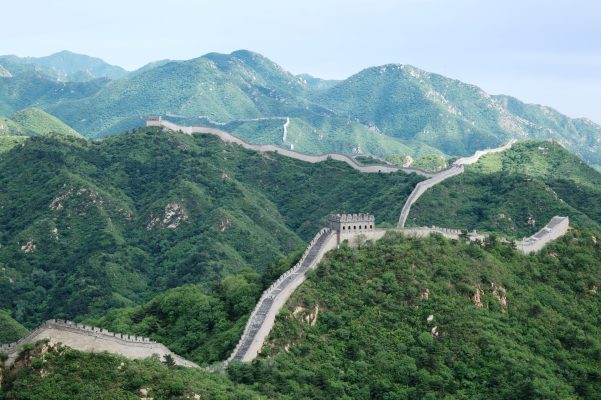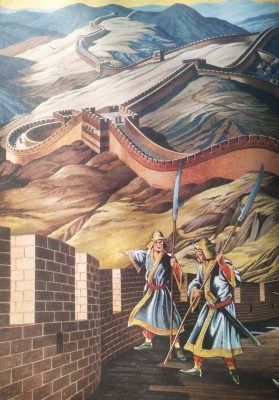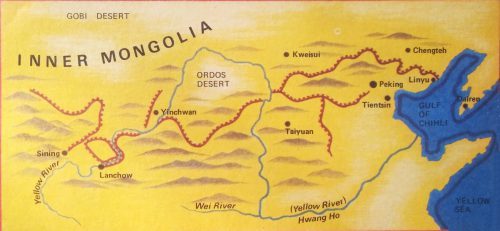Visible from the Moon, China’s Great Wall is perhaps the most ambitious defence system ever created but it is also a monument to cruelty and grief.
 Pin
Pin Even among the awesome band of princes who ruled eastern lands thousands of years ago, Shih-hwang-ti was a most unusual monarch. Every day he was in fear of assassination, and to put off would-be murderers he never slept in the same room for two successive nights.
The need for plenty of bedrooms was Shih-hwang-ti’s least concern. He was a passionate builder, and he had 170 palaces. The largest of them was said to have so many rooms that if he lived in a different one each day it would have taken him thirty-six years to use them all.
Shih-hwang-ti was Prince of the Chinese province of Ch’in when, in 221 B.C., he declared himself the first Emperor of a united China. The vigour and authority of his rule was soon the talk of the East. He broke the power of the feudal families of China and appointed military and civil officials to administer the great areas of land within his power. The type of government which he set up survived in China until this century.
 Pin
Pin This impression of the Great Wall of China shows how it wound up and down over the hilly terrain. The narrow slots of the battlements gave bowmen room to shoot down on attackers, while providing maximum protection. The two guards are infantrymen, they wear heimets of metal or leather, but they have no armour. They are clad in buiky coats made up of loose layers of tightly woven silk. These garments were difficult to cut through with a blade and also resisted arrows. if an arrow did manage to pierce the flesh of the wearer the arrowhead would usually become swathed with a piece of silk. This made it easier to remove the arrow and also protected the wound from further damage caused by the barbs when the arrow was removed. The guards are armed with swords and polearms, sharp metal blades mounted on long handles. This type of equipment was in use when the Wall was built and continued to be used for several hundred years.
Enemies
Shih-hwang-ti saw enemies everywhere — outside as well as within his new empire. Soon after he had made himself Emperor he hit on the idea of using his great building urge to keep himself safe from some of these enemies.
In the north of his vast territories, barbarian marauders — the Hsiung-nu, who were ancestors of the warlike Huns who later invaded Europe — were perpetually making inroads from their own bleak country into the well-cultivated, fertile land of China.
Shih-hwang-ti’s predecessors in the north had already built some sections of defensive walling to keep out the Hsiung-nu. Now the barbarians made a concerted attack on this half-defended frontier. The new Emperor sent 300,000 soldiers to drive them back, and when the victory was his he resolved to build a-wall that would not only keep out the barbarian enemies, but would also keep the Chinese in and firmly mark the frontier.
Shih-hwang-ti never built anything by half-measures. His Wall was going to be one-twentieth of the circumference of the Earth, and to construct it he pressed into service one-third of all the able-bodied men in his empire. It didn’t matter how unsuitable they were for the task — writers, clerk, tax officials and common criminals were all forced to toil side by side in order to build the Great Wall of China.
The Emperor had scant regard either for the lives or the welfare of his people. Like ants they were sent north to work in huge flocks on the wall — perhaps a million men and women died in the years of its construction. Prisons disgorged their inhabitants to swell the work-force and prisoners-of-war were sent there to toil — and probably die.
The work went on through all changes of climate —the heat of desert summers, the icy winters. The Wall rolled on, through sand and mud and scaled mountainous heights. It was not allowed to cease.
The immensity of the task, and the savagery of it, staggers the imagination. Where human labour was available in infinite measure, nothing was impossible, no task too great to be undertaken. If the materials for construction were not at hand, then they had to be brought from no matter how far away, at no matter what expense.
The Wall was really a double wall. Hard brick outer walls were filled with clay and built on foundations of stone. About ten metres up, along the top of the Wall, was a roadway wide enough eight men to march abreast and for horses and chariots to travel along.
 Pin
Pin Salvation
Every hundred metres or so there was a watch-tower, standing out from the Wall. From these strongholds signals could be sent to warn soldiers along the Wall of imminent enemy attack. Probably about 25,000 of these towers were built along the Wall.
China is a land that preserves her memories in tales and legends. Within them is a germ of the truth. Stories are told of the men who fell ill as they worked and how they were trampled into the Wall along with the clay; of those who died and were thrown in also.
But, as a Chinese proverb says, “The annihilation of one generation has proved the salvation of others,’’ and for many years the Great Wall served its purpose well, even playing its part as late as 1933 in protecting the Chinese against the attacking Japanese.
For the size of such a feat very little was recorded about this monumental and extraordinary Wall. What now remains of it has often been rebuilt and repaired.
In the ten more years that Shih-hwang-ti reigned after he commanded the Wall to be built, about 1,500 miles of it (about half its total length) were completed. It stretched from the east coast, near the site of China’s modern capital of Peking, for hundreds of miles westwards, crossing the great Yellow River. The rest of the Wall was completed under later Emperors.
The height and size of the Wall diminish somewhat as it progresses westwards, but to the end it maintains its high quality of workmanship. Starting from Shan-hai-Kwan, it runs west across the mountains to Kalgan. Then it goes over the plains and lesser ranges of the Hwang-ho basin. From that point the existing boundary between Mongolia and China is faithfully followed to Kiayu Kwan, where the Wall comes to a sudden end.
Modern research has shown that the Great Wall branches off into two distinct loops near Chunwei, and that another loop enclosed a large tract of land west of the capital. Excluding these loops, the Great Wall would stretch from Berlin to Tiflis in the Caucasus.
In the year 210 B.C. Shih-hwang-ti died — and, since he had told everyone that he was immortal, that came as a considerable shock to the court. They believed, therefore, that there must be some mistake, and that the Emperor wasn’t really dead. They sat his body in a sedan-chair and carried it all over the vast country, stopping only long enough to allow it to give ‘‘audiences’’. At the end of nine months, no doubt persuaded by the bad smell, they finally decided that Shih-hwang-ti really was dead, and buried him.
So its your turn. What are your thoughts about The Great Wall of China? Share it below in comment section.
The Great Wall of China was built for several reasons:
The Great Wall of China was built as a formidable defensive structure, but it also served as a unifying symbol, controlled trade and population movement, and facilitated communication and logistics within different regions of China.
The construction of the Great Wall of China was primarily prompted by several historical events and threats that the Chinese empire faced. Here are the main factors that led to its construction:
Over time, the Great Wall evolved in response to changing needs:
- 1. Expansion and Reinforcement: Each dynasty that ruled China contributed to the expansion and reinforcement of the wall. During the Ming Dynasty, the wall’s construction reached its peak, spanning over 13,000 miles. It involved the use of bricks, watchtowers, beacon towers, and other defensive elements. The Ming Dynasty also implemented strict border control measures, including military garrisons stationed along the wall.
- 2. Communication and Signaling: The wall not only served as a physical barrier but also played a crucial role in communication and signaling systems. Signal towers were built along the wall, allowing rapid transmission of messages between different sections. Smoke signals, beacon fires, and flags were used as means of communication over long distances.
- 3. Economic and cultural exchange: As the threat of invasions decreased over time, the Great Wall gradually transformed from a defensive structure to a means of managing commerce and cultural exchange. Some parts of the wall began to function as checkpoints, collecting taxes on trade goods passing through. It also facilitated the exchange of goods, ideas, and technologies between the Chinese civilization and the nomadic tribes.
Threats from northern nomadic invasions and the need for unification and defense against neighboring powers prompted the initial construction of the Great Wall. Over time, it expanded, strengthened, and took on additional roles such as communication, trade management, and cultural exchange. The evolution of the Great Wall reflects the changing needs and priorities of the Chinese empire throughout different dynasties.
The Great Wall of China had significant long-term effects in terms of defense, trade, and cultural impact
Defense:
- 1. Military defense: The primary purpose of the Great Wall was to protect China from invasions by nomadic tribes such as the Mongols. It served as an effective barrier, deterring and slowing down invasions, providing the Chinese military with strategic advantages.
- 2. Symbol of national defense: The Great Wall became a symbol of Chinese resilience, unity, and national pride. It instilled a sense of security among the Chinese people and played a crucial role in shaping Chinese identity.
Trade:
- 1. Regulation of trade: The Great Wall served as a means to control and regulate trade along the Silk Road, a major trade route connecting China with Western Asia and Europe. The Wall had gates and checkpoints, where tolls were collected and trade goods were inspected, allowing the Chinese government to exercise control over trade.
- 2. Economic impact: The Great Wall’s role in protecting trade routes contributed to economic stability and development. It facilitated safe passage for merchants, fostering the growth of commerce and the exchange of goods, ideas, and cultural influences.
Cultural Impact:
- 1. Architectural marvel and cultural heritage: The Great Wall is a remarkable feat of engineering and an iconic symbol of Chinese civilization. Its construction involved the labor of millions and has become a testament to the ingenuity, determination, and skill of the Chinese people. It is recognized as a UNESCO World Heritage site and attracts millions of tourists each year.
- 2. Cultural integration: The Great Wall played a crucial role in integrating diverse cultures within China. As the Wall stretched across vast regions, it became a melting pot, allowing for the interaction of different ethnic groups. This cultural integration led to the spread and exchange of ideas, languages, and religions.
- 3. National unity: The Great Wall served as a unifying force for the Chinese people, fostering a sense of shared history, cultural identity, and national consciousness. It contributed to the formation of a cohesive Chinese state by reinforcing a collective memory and pride in their heritage.
The Great Wall of China had a profound and lasting impact on defense, trade, and cultural aspects of Chinese civilization. It served as an effective defense barrier, regulated trade routes, shaped Chinese identity, and became an architectural and cultural icon.
There are several sections of the Great Wall of China that are recommended for tourists to visit. The most popular and well-preserved sections include:
It’s important to consider factors such as accessibility, level of restoration, crowds, and personal preferences when choosing a section to visit. Ultimately, each section offers its own unique charm and experience, so it’s advisable to do some research and decide based on individual interests.
Frequently Asked Questions about the Great Wall of China
The Great Wall of China is a vast and ancient fortification system built to protect different Chinese dynasties from potential invasions. It is a series of walls and towers that stretches for thousands of miles across the northern regions of the country.
The construction of the Great Wall of China began around the 7th century BC during the ancient states of Qi, Yan, and Zhao. However, the most famous sections we know today were built during the Ming Dynasty, from the 14th to 17th centuries AD.
The exact length is debated among historians, but the current estimated length of the Great Wall is approximately 13,171 miles or 21,196 kilometers. This measurement includes all the various sections and branches of the wall.
The construction of the Great Wall involved an enormous workforce of soldiers, peasants, and prisoners. Materials like stones, bricks, wood, and earth were used to build the walls and watchtowers, with control of passes and important strategic points. Constructing the wall was an arduous process, involving manual labor, engineering skills, and strategic planning.
Yes, some sections of the Great Wall of China are open to the public and can be explored. The most visited sections include Badaling, Mutianyu, and Jinshanling, which have been restored and equipped with facilities to accommodate tourists.
Walking the entire length of the Great Wall is not practically feasible due to its length and the state of the different sections. Some areas are dilapidated, while others are located in remote and rugged terrains. It is more common for visitors to explore certain sections of the wall rather than attempting to walk the full distance.
Yes, the Great Wall is open to visitors year-round. However, the best time to visit is during spring (April-May) and autumn (September-October) when the weather is pleasant, and the scenery is beautiful. The summer months can be hot and crowded, while winter brings cold temperatures and limited accessibility to certain sections.
The entrance fees to different sections of the Great Wall can vary. Generally, the most popular sections, such as Badaling and Mutianyu, charge around 40-60 Chinese yuan (approximately $6-9) per person. There may be additional costs for cable car rides or other attractions within the sections.
Visitors to the Great Wall are advised to wear comfortable clothing and footwear as some sections can involve steep climbs and uneven terrain. It is recommended to carry water, sunscreen, and a hat, especially during the summer months. Visitors should also adhere to safety instructions and signage to avoid any accidents while exploring the wall.
Yes, visitors should respect the historical and cultural significance of the Great Wall. Carving, graffiti, and any other form of damage to the wall is strictly prohibited. Additionally, climbing on fragile sections, removing bricks or stones, or littering is highly discouraged. It is important to remember that the Great Wall is a protected heritage site and should be treated with care and respect.


































